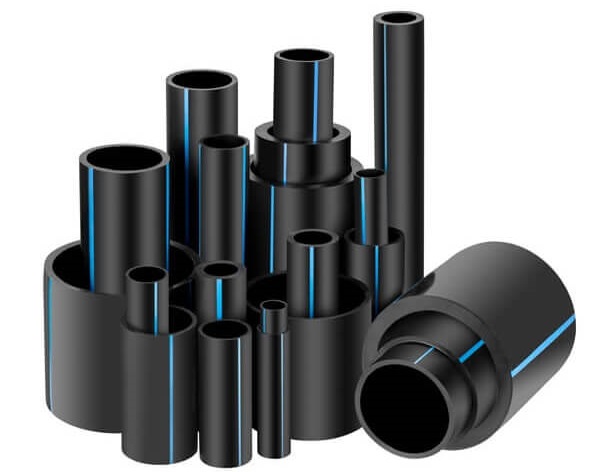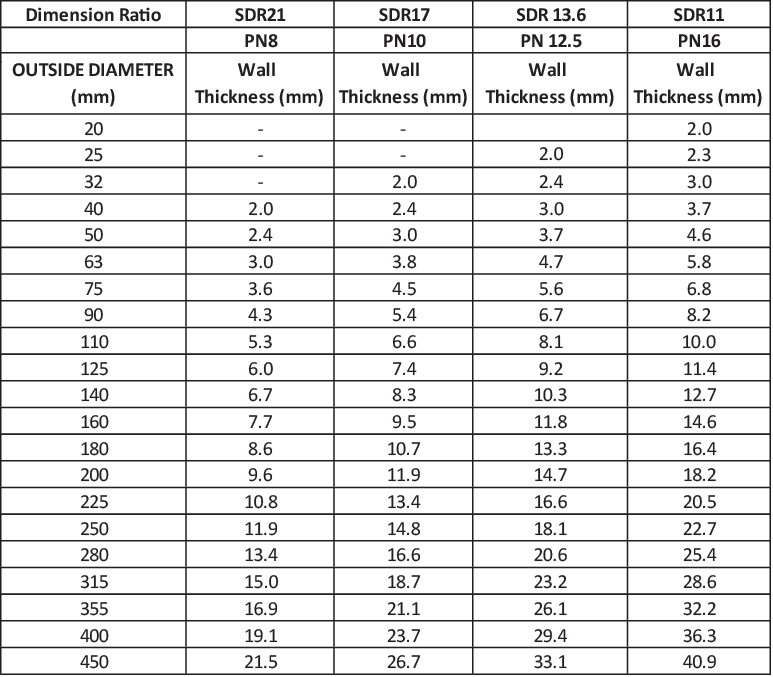


PE-100 Pipes & Fittings
As Per ISO 4427, DIN 8074 / 8075 & PS 3580
POPULAR HDPE (High Density Polyethylene) pipe is ideal for many different applications including municipal, industrial, energy, geothermal, landfill and more. POPULAR HDPE pipe is strong, durable, flexible and light weight. When fused together, POPULAR HDPE pipe has a zero leak rate because the fusion process creates a monolithic, HDPE system. POPULAR HDPE pipe is more environmentally sustainable option as it is non-toxic, corrosion and chemical resistant, has a long design life, and is ideal for trenchless installation methods because of its flexibility.
INSTALLATION
PE-100 pipes are tough, flexible, light weight and offer many cost saving advantages in both above ground and below ground installations. Whilst they are robust and resistant to site damage normal care and sensible handling practices are necessary to ensure trouble free operations.
Pipe Trench
Note: When groundwater levels are expected to reach above the pipe, the secondary initial backfill should be a continuation of the primary initial backfill in order to provide optimum pipe support. Minimum trench width will depend on site conditions and embedment materials.
Foundation: A foundation is required only when the native trench bottom does not provide a firm working platform for placement of the pipe bedding material.
BUTT-FUSION & WELDING
Butt welding (or butt fusion) is the most common jointing method for PE pipes. It is made by inserting a heater plate between the ends of two pipes, which are then brought together under pressure – this softens the ends of the pipe. The heater-plate is then removed and the pipes are brought together again and allowed to cool under pressure, this results in a high-tensile, leak tight homogeneous joint.
COMPRESSION COUPLING JOINT
Normally, the availability of compression fitting is in relatively small diameters. After being cut vertical to its own axis, the pipes are connected to each other by means of coupling adapter. When both pipes are held in position by the coupling adapter, bolts are then tightened by hands to make a robust connection. However, pipes having a diameter 40mm or higher, tightening bolts by hands is not recommended. A special wrench has to be used in that case. Thus, for pipes with diameters more than 110mm, joining method is not recommended.
PRODUCT RANGE
POPULAR HDPE PIPES with range of sizes as per ISO 4427, DIN 8074/8075 & PS 3580 standards. The details of all available sizes is as under:

HDPE is fast replacing the conventional piping systems for water supply and distribution. Worldwide it is being for new projects and used as a replacement to the existing piping networks.
FEATURES & BENEFITS
- Cost saving solutions
- Leak free joints
- High fatigue resistance
- Flexibility
- High seismic resistance
- Light weight
- Ease of joining
- Durability
- Ductility
- Excellent flow characteristics
- Robust for extreme weathers
- Wider operating temperature range (-30 to +60)
- Tear and pressure resistant
- Low flow noise
- Non-toxic
- Suitable for radioactive waste
Handling, Unloading and Storage
HDPE material falls in the range of flexibility, light weightiness and easy handling. However, precautions must be taken to not to scuff or gouge the surface while handling. The flexibility of PE’s leads to cost saving during the installation process. It also reduces the cost required for joints and fittings since it can be coiled to be supplied in long lengths. Cost saving techniques take advantage of low weight and flexibility during the transportation which reduces disturbances for the environment and the public. Another advantage for PE’s include trench-less technology. Long lengths of PE can be laid down by pulling it through holes below ground which are bored by mechanical moles. This eliminates the need for digging open trenches. Normally, PE is used for revamping of old pipes and it is done by inserting a PE inside the old pipes as lining.
Safety Measures
- Pipes should be store flat on a firm ground which can withstand the weight of the pipes/fittings.
- Non-metallic slings should be used such as polypropylene or nylon.
- Pipe/fittings should be kept safe from sharp objects.
- Pipe/fittings should be stored under protective packaging.
- Pipes/fitting should be kept away from intense heat.
- Don’t place pipes or fittings in contact with aggressive chemicals.
- Don’t drag or roll individual pipes or bundles.
- Don’t throw away pipes and fittings from vehicles delivering them.
- Avoid metal slings, chains or hooks for handling for pipe safety.
- Don’t expose pipe/fitting to intense heat for long time.


